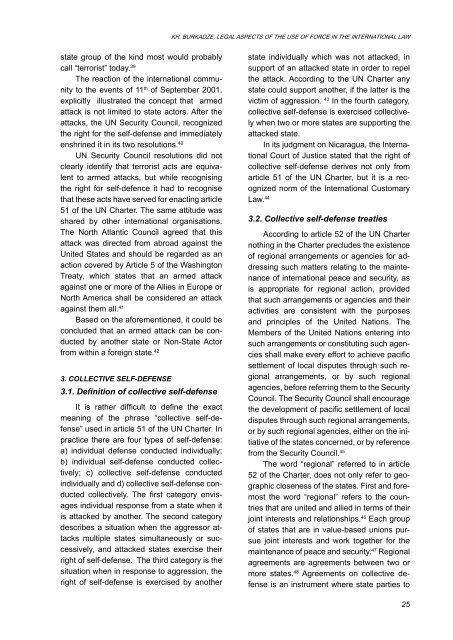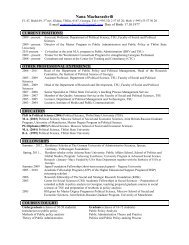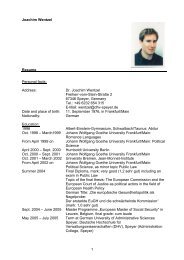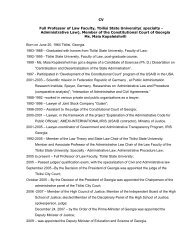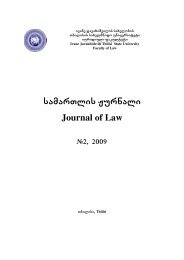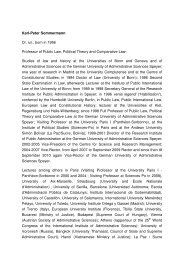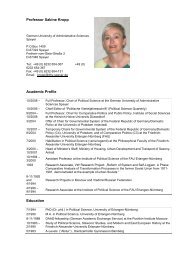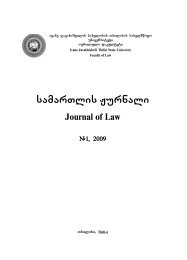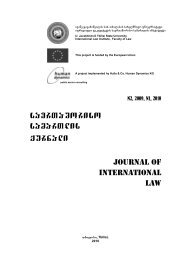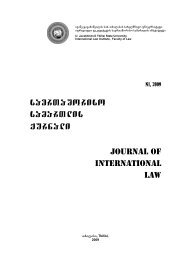Journal International Law_N2-10.indd
Journal International Law_N2-10.indd
Journal International Law_N2-10.indd
Create successful ePaper yourself
Turn your PDF publications into a flip-book with our unique Google optimized e-Paper software.
KH. BURKADZE, LEGAL ASPECTS OF THE USE OF FORCE IN THE INTERNATIONAL LAWstate group of the kind most would probablycall “terrorist” today. 39The reaction of the international communityto the events of 11 th of September 2001,explicitly illustrated the concept that armedattack is not limited to state actors. After theattacks, the UN Security Council, recognizedthe right for the self-defense and immediatelyenshrined it in its two resolutions. 40UN Security Council resolutions did notclearly identify that terrorist acts are equivalentto armed attacks, but while recognisingthe right for self-defence it had to recognisethat these acts have served for enacting article51 of the UN Charter. The same attitude wasshared by other international organisations.The North Atlantic Council agreed that thisattack was directed from abroad against theUnited States and should be regarded as anaction covered by Article 5 of the WashingtonTreaty, which states that an armed attackagainst one or more of the Allies in Europe orNorth America shall be considered an attackagainst them all. 41Based on the aforementioned, it could beconcluded that an armed attack can be conductedby another state or Non-State Actorfrom within a foreign state. 423. COLLECTIVE SELF-DEFENSE3.1. Definition of collective self-defenseIt is rather diffi cult to defi ne the exactmeaning of the phrase “collective self-defense”used in article 51 of the UN Charter. Inpractice there are four types of self-defense:a) individual defense conducted individually;b) individual self-defense conducted collectively;c) collective self-defense conductedindividually and d) collective self-defense conductedcollectively. The fi rst category envisagesindividual response from a state when itis attacked by another. The second categorydescribes a situation when the aggressor attacksmultiple states simultaneously or successively,and attacked states exercise theirright of self-defense. The third category is thesituation when in response to aggression, theright of self-defense is exercised by anotherstate individually which was not attacked, insupport of an attacked state in order to repelthe attack. According to the UN Charter anystate could support another, if the latter is thevictim of aggression. 43 In the fourth category,collective self-defense is exercised collectivelywhen two or more states are supporting theattacked state.In its judgment on Nicaragua, the Inter nationalCourt of Justice stated that the right ofcollective self-defense derives not only fromarticle 51 of the UN Charter, but it is a recognizednorm of the <strong>International</strong> Customary<strong>Law</strong>. 443.2. Collective self-defense treatiesAccording to article 52 of the UN Charternothing in the Charter precludes the existenceof regional arrangements or agencies for addressingsuch matters relating to the maintenanceof international peace and security, asis appropriate for regional action, providedthat such arrangements or agencies and theiractivities are consistent with the purposesand principles of the United Nations. TheMembers of the United Nations entering intosuch arrangements or constituting such agenciesshall make every effort to achieve pacifi csettlement of local disputes through such regionalarrangements, or by such regionalagencies, before referring them to the SecurityCouncil. The Security Council shall encouragethe development of pacifi c settlement of localdisputes through such regional arrangements,or by such regional agencies, either on the initiativeof the states concerned, or by referencefrom the Security Council. 45The word “regional” referred to in article52 of the Charter, does not only refer to geographiccloseness of the states. First and foremostthe word “regional” refers to the countriesthat are united and allied in terms of theirjoint interests and relationships. 46 Each groupof states that are in value-based unions pursuejoint interests and work together for themaintenance of peace and security. 47 Regionalagreements are agreements between two ormore states. 48 Agreements on collective defenseis an instrument where state parties to25


